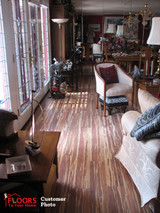Getting the Look You Want

Listen to this article:
|
It is likely that there is a laminate for every wood species ever used for flooring, as well as for a variety of styles of stone and ceramic flooring. Remember that the look of a particular kind of laminate flooring comes from the photo fused onto the core board, so laminates can look like anything that can be photographed. There are so many options in laminate flooring today that there is no reason you shouldn’t be able to get the exact style that you’re after. Yes, market demands might prevent a look like “Scattered Gravel” or “Sharp Tacks and Nails All Over the Place” from being produced due to a low demand for those looks in a floor, but otherwise it should look just like you want it to. There are also variants of each of those styles because of differing plank sizes and different finish types. Textured surfaces can enhance the overall impression, making the images dazzlingly realistic. Buying a new floor is a pretty big deal. Even if the expense doesn’t have a once-a-decade feel for you, it is still something you will live with, and live on, for quite a while. Now, we work to make our pictures and descriptions as accurate as possible, but we still can’t control differences from computer monitor to computer monitor. |
This is why we really can’t understate how valuable samples could be for you in making this decision. We can send you good sized pieces, the full width of the planks by about eight inches, so you can hold them in your hand and see them right in your room. It’s a great way to check out the features, and we’ll go over those features with the idea of your having samples in mind, so you can get the most out of having them in hand.
Features of laminate flooring
Aside from the broadest categories, wood or stone for instance, which you can probably navigate without our aid, here are some things to consider, especially when choosing your wood style laminate floor, and evaluating samples.
Color & Tone
While technically not the same things, with Laminate flooring they effectively are. We’re talking about an overall color sense. With hardwood, any species can be stained, and so with laminate flooring we can have a cherry that looks brown, or one that looks red. It’s the impression one will get when standing back and looking at a whole room. If you can’t get a fix on the rough coloring, with a sample for instance, set the sample down, propped by a pillow on a couch, and step back from it. With the wood details lost in distance, it might be easier for you to determine “This is a ‘golden’ floor”. We separate our flooring into such categories, so if you know the overall color of your room, that might help you find the specific flooring you need. You should know that an installed floor can sometimes seem a little darker than your samples. More of the darker color covering your floor will absorb more light in general. Also, if you’re holding a sample while you stand, you might be closer to a window or light source than your floor is. It’s just something to consider, certainly not a universal thing. Below you’ll see a variety of tones or colors of Maple.
The word “tone” might help make a useful verbal distinction, as if it is a sub-quality of color. If you have a style of laminate you mostly like, but is not quite right, you might be able to determine about, say, a golden colored sample that it needs to be less yellow in tone. Since you can communicate that to a customer service person, and they know our products by sight, they should pretty easily lead you to some good, new options for your room.
Grain
What you can determine with samples is how prominent the grain look is for your particular choices. Some have little to no grain, while for other types the grain is so sharp and dark that it defines the floor. It is an important consideration. What a single sample may not show you is variation in grain. Some grain patterns are basically long and straight, or just mildly arced. Others can go a little wild here and there, swirling into “bird’s eyes”, or suddenly diverting in direction. Since your sample is only one piece of one plank, if you want a sense of the variations, go back to the product page on our site, where we'll have fuller images, room images, and in most cases, the product will be available in our Room Visualizer. Or please just call us, and we can describe it, or even send you pictures of a few representative planks to give you good grasp on your choice.

|

|

|

|

|

|

|

|

|

|

|

|
Finish
Finish is the top, protective layer, but in addition to protecting, it has an effect on how the board looks. The basics are high gloss and matte, with semi-gloss falling in the middle. High gloss is usually referred to by salesmen as a “piano finish”. It’s striking, and one of the best reasons you should get a sample, so you can see it. Matte means the manufacturer deliberately made the surface less slick, less reflective. If you’re not sure with which type of finish you will be happiest, please get a sample of each. There is no substitute for having the actual floor in hand so you can see it for yourself.
Texture
The top surface of your floor might have a texture other than “smooth”. Laminate technologies are almost developing faster than animation did in the 1930’s, and one of the recent features is the availability of textured surfaces that can resemble the natural hand-scraped look of hardwood flooring. The two main types are hand scraped and distressed. In some cases, the grain in the image and the texturing are made to match up exactly, a feature called “ embossed in registration“. The pictures below will open larger in new windows. Look in the glare and you’ll see how these surface differences look.
Edges
The edges of your laminate can be designed to do one of two things, not show division between the planks at all, or deliberately reveal them. The first will leave you with one, big, smooth floor, the kind you want to slide around on in your clean socks. The edges of this type are called “squared”, if they are called anything. The second kind will have beveled (or micro-beveled) edges, where each edge curves or angles down, rather than dropping at a 90 degree angle. When boards meet, the edges create grooves, like one would have between boards of hardwood, and that’s why these exist, to enhance the hardwood look. Another enhancement is called “French Bleed”, where the edges have a darkened, almost burnt look, adding to the real wood effect.

|

|

|
– – – –
David has written and made videos about flooring products and installation since 2011 at Floors To Your Home (.com), where he is also the PPC Manager, a Researcher, a Website & Marketing Strategy Team member, Videographer, Social Strategist, Photographer and all around Resource Jito. In my spare time I shoot and edit video, put together a podcast, explore film history, and mix music (as in ‘play with Beatles multi-tracks’). Connect with
W. David Lichty
Follow Team Floors To Your Home on Facebook

 Brown Tone
Brown Tone
 Red Tone
Red Tone
 Golden Tone
Golden Tone
 Gray Tone
Gray Tone
 Light Tone
Light Tone
 Medium Tone
Medium Tone
 Dark Tone
Dark Tone
 Brown Tone
Brown Tone
 Red Tone
Red Tone
 Golden Tone
Golden Tone
 Gray Tone
Gray Tone
 Light Tone
Light Tone
 Medium Tone
Medium Tone
 Dark Tone
Dark Tone
 Multi Color
Multi Color


















